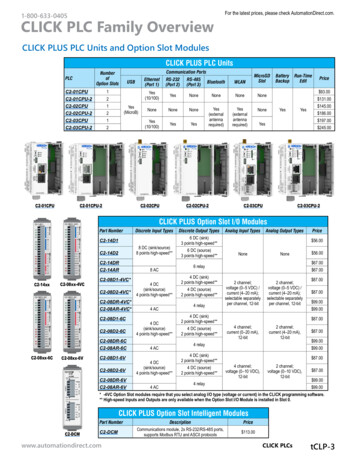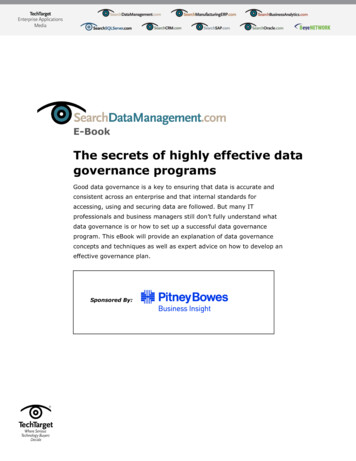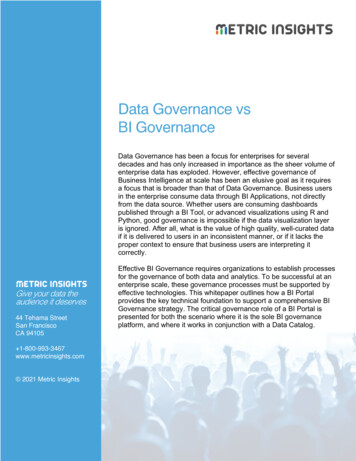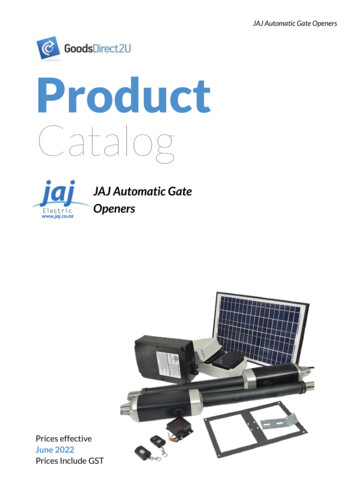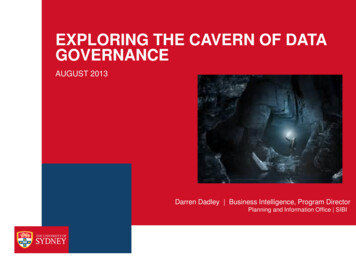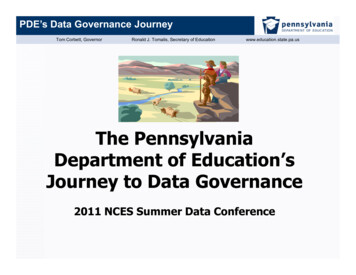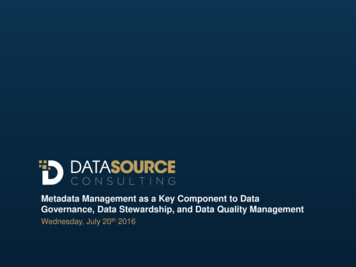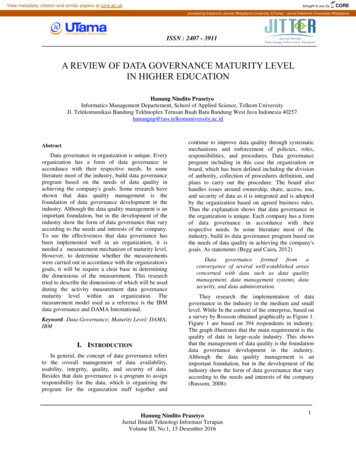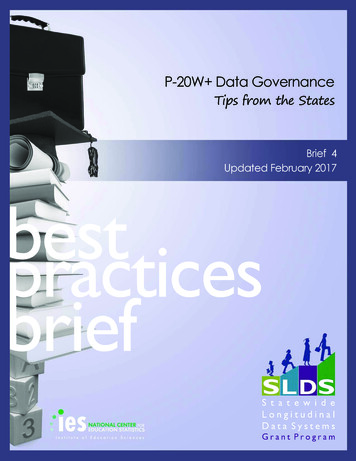
Transcription
P20W DataGovernanceTipsfrom efStatew ideLongitudinalDataSystemsGrantProgram
SLDS Best Practices BriefP-20W Data GovernanceIn general, data governance refers to the overall management of the availability,usability, integrity, quality, and security of data. A sound data governance programincludes a governing body or council, a definition and allocation of authority, adefined set of procedures, and a plan to execute those procedures. This briefoffers best practices for establishing and maintaining a P-20W data governancestructure. It includes examples from states with experience setting up P-20W data governance.Data governance is both an organizational process and a structure. It establishesresponsibility for data, and it organizies program area and agency staff tocollaboratively and continuously improve data quality and usability and to ensuredata security and confidentiality through the systematic creation and enforcementof policies and procedures. Data governance also ensures efficient and effectivecollaboration, authority, and accountability by defining and assigning clear rolesand responsibilities.This document relates to P-20W or interagency data governance rather thanK12 or intra-agency data governance. While there are many similarities instructure and process between interagency and intra-agency data governance,there are key differences. For example, among the various P-20W agencies,there may be varying security requirements, processes for data sharing, data useand reporting priorities, and timelines. There also may be a different, broaderresearch agenda at the P-20W level, whereas intra-agency priorities tend tofocus on the education programs overseen by that specific agency. (See figures1 and 2 on pages 2 and 3, respectively, for depictions of single-agency versusP-20W data governance structures.)When data governance is effectively established, the quality of data collected,reported, and used by state and local education agencies—as well as earlychildhood, postsecondary, and other agencies such as the Department ofLabor or Department of Health—is enhanced; staff burden is reduced; andcommunication, collaboration, and relationships with the various agencies,information technology (IT) staff, and program areas are improved.P-20W refers to data from prekindergarten (early childhood), K12, andpostsecondary through post-graduate education, along with workforceand other outcomes data (e.g., public assistance and corrections data).The specific agencies and other organizations that participate in aP-20W initiative vary from state to state.SLDS Best Practices Brief: P-20W Data GovernanceBrief 4Updated February 2017This product of the Institute ofEducation Sciences (IES) SLDSGrant Program was developedwith the help of knowledgeablestaff from state educationagencies. The views expressed donot necessarily represent those ofthe IES SLDS Grant Program.We thank the following people fortheir valuable contributions:Melissa BeardWashington State Education Research& Data CenterJan KiehneConnecticut State Collegesand UniversitiesTod MassaState Council of Higher Educationfor VirginiaRon ParrishVirginia Department of EducationKirsten RoweVirginia Department for Aging andRehabilitative ServicesJeff SellersSLDS Program, State Support TeamFor more information on the IESSLDS Grant Program, additionalBest Practices Briefs, or forsupport with system developmentor use, please visithttp://nces.ed.gov/programs/SLDS.1
Initial Steps to Establishing P-20W Data Governance1.P-20W partners identify education policies, priorities, challenges, and needs that spanmultiple agencies.2.Partners develop the initial draft of the P-20W data governance policy, using the P-20W education policies as a foundation and the initial step for governance. Authority for P-20W data governance should be granted via executive order, state statute, or as part of memorandaof understanding (MOUs). Either a single MOU for all partners or a separate MOU for eachparticipating agency can serve as the administrative vehicle for responding to P-20W educationpolicy initiatives.3.State leadership1 reviews and approves the P-20W data governance policy.4.The leadership disseminates the policy to staff and to executive and legislative leadership, includinga reference to where it will be available electronically.5.The leadership identifies P-20W data governance leads, establishing the membership of theP-20W Data Governance Committee.6.The P-20W Data Governance Committee uses the policy as the foundation for its P-20W datagovernance manual2, which details how the policy will be put into practice.Figures 1 and 2 depict two data governance approaches:intra-agency (single agency) and interagency (multipleagencies). The intra-agency approach (figure 1) is anagencywide approach to managing information fromcollection through use. There should be distinctroles for and relationships among program areas,IT, and leadership, as well as local education agencyrepresentation and an agencywide data governancecoordinator. Information is owned at the programarea level, and each data element has one owner.Figure 1. A traditional data governance structure for a single agency (a K12 agency is used as an example)State leadership includes leadership from those agencies participating in the P-20W system, along with leadership from the governor’soffice and legislature.2The SLDS State Support Team has developed a P-20W Data Governance Manual Example and a P-20W Data Governance ManualTemplate that are available in the Public Domain Clearinghouse. See the Additional Resources section at the end of this brief.12SLDS Best Practices Brief
The interagency approach (figure 2) offers a statewideperspective on data use to inform education policyand priorities. Roles for and relationships amongstate leadership and the leadership, program, and datamanagement staff of participating agencies shouldbe distinct and defined. In addition, state leadershipand agencies should work together on data sources,integration, reporting, and use. Information is ownedat the agency or program-area level. A P-20W DataGovernance Committee chairman serves as point ofcontact for, and facilitates communication between, theExecutive Leadership and the Data Steward Workgroup.Both groups should include representation from allagencies participating in the P-20W SLDS.Figure 2. Data governance across P-20W partner agenciesDo:According to states, the following practices areeffective ways to establish P-20W data governance.Engage state leadership.Fully engage state leadership (Executive Leadershiplevels of figures 1 and 2) early in the development ofP-20W data governance. Without this engagement,both short-term effectiveness and long-termsustainability of the P-20W system may be injeopardy. Support from Executive Leadership helpsfoster the initial establishment of P-20W datagovernance, provides authority for cross-agencyP-20W Data Governancedecisions, and defines the commitment of personneland other resources so that the ongoing needs ofP-20W data governance can be met.Pay attention to legislative activity inyour state.Many states have legislation impacting how data canbe collected, where they can be stored, and who hasaccess to them. During the planning phase, research allpossible legislation that could impact your work. If statelaws limit data sharing, there may be an opportunityto lobby to change the laws—particularly if the state3
already has legislative and executive support forP-20W work. Additionally, demonstrating how theP-20W system can support legislative interests canhelp secure legislative backing and build momentumfor a state’s data collection efforts.If a lack of state legislation affecting P-20W datacollection, storage, and access is hindering the effort,develop relationships through appropriate channelsto begin the process of crafting legislation that willsupport the project. Otherwise, use the lack oflegislation as an opportunity to develop the systemwhile involving policymakers from the beginningso that there is buy-in for the project and it can besustainable in the future.Washington’s Approach to P-20W Data GovernanceThe Washington State Legislature created the Education Research & DataCenter (ERDC) in 2007 to help the state answer questions about educationoutcomes that no single agency at the time could answer. ERDC managesa centralized data warehouse containing data from state early learning,K12 and postsecondary education, and workforce agencies that are usedfrequently for reports and research. Datasets from additional sources, such ascorrections and justice programs, can be linked to education data for specificreports or analyses but are not regularly collected in the warehouse.Although ERDC’s role in linking and managing data from multiple state agencies was established in law,the center soon recognized that the success of its P-20W work depended on building strong relationshipsand trust with its data contributors. Because ERDC is housed in the Office of Financial Management, whichalso oversees the state’s budget, some agencies feared their data would affect the funding they receive.Some also worried about the time and work involved in contributing data to ERDC.ERDC’s data governance efforts began before it decided on the technical architecture for its datawarehouse. Leaders spent eight months meeting with data contributing agencies at the start of the project.They often met multiple times with stakeholders who were most concerned about data sharing, discussingwith them the valuable information they would gain by sharing their data.Clarifying and documenting ERDC’s role and data governance processes also helped address concerns.Memoranda of understanding among all the state agencies outline the expectations and responsibilitiesof each partner, including ERDC. They also cement ERDC’s focus on questions affecting multiple P-20W sectors rather than single sectors and agencies.Three groups contribute to data governance in Washington: The Research Coordination Committee is composed of research and policy representatives fromagencies that contribute and use ERDC data. The group meets quarterly to revisit data sharing policies,discuss upcoming work, and hear presentations from data users about recent projects. The Data Custodian Group includes IT personnel from data contributors concerned with how data aretransported to and stored at ERDC. The Data Stewards Group consists of data experts from each contributing agency who are familiarwith what their data mean and how they can be used.ERDC meets with data custodians and data stewards at contributing agencies as needed to discuss datasharing procedures and to make adjustments for any changes to the datasets they submit. To minimizeburden on its data contributors, ERDC built its data warehouse to accept datasets from source systems in avariety of formats rather than asking contributors to conform to a single standard.Although ERDC maintains the linked data and has the authority to release data on behalf on individualagencies, its data governance culture recognizes each agency as the expert on its own data. Questionsabout specific data are directed to the contributing agency rather than to ERDC. ERDC also works withresearchers and state agencies to provide data that are not regularly collected in the statewide warehouse.4SLDS Best Practices Brief
Convene all relevant parties. Educateeach other to develop data knowledgeand buy-in.Once the Executive Leadership has defined the visionand direction for the P-20W system, data governanceis needed to effectively implement this vision. Bringall involved stakeholders to the table and discuss whydata governance is important and how it will benefiteach of the participants in the P-20W partnership,as well as the state as a whole. In addition, discuss anddocument what data are already being collected—andby whom—within the state. The group can then beginto visualize which data could be shared, as well as whatbenefit sharing data can have for each of the relevantpartners. Discussions are also needed to determinehow these data can address and support the visiondefined by Executive Leadership. Such conversationscan create a sense of ownership and common interest,and they can help alleviate any concerns participantshave about misuse or loss of authority over their data.Establishing trust and common interest is vital to datagovernance efforts.Possible partners in this discussion include keyleadership at the executive level, director-levelrepresentatives from each agency, agency programarea data steward representatives, and IT and dataanalysis staff from participating agencies. The key is toestablish a committee structure that meets the needsof the state and is responsive to the culture. Generallythere are three types of committees: (1) ExecutiveConnecticut’s Approach to P-20W Data GovernanceThe five agencies involved in Connecticut’s P20 WIN SLDS collaborate voluntarily toshare data for cross-agency projects, reports, and research. When approaching datagovernance, the project leaders knew they needed to formalize the collaboration theystarted during the state’s 2009 SLDS grant. They wanted a data governance approachthat engaged the right people from each organization, gave them equal representation,and facilitated decisionmaking without becoming a burden on participants.The P20 WIN data governance model is composed of three groups: The Executive Board includes one leadership-level member from each of the five partner agencies.The board advocates for P20 WIN initiatives, sets the strategic vision for the project, approves newagencies joining the effort and related agreements, and addresses issues that affect all partneragencies. Members meet on an as-needed basis. The Governing Board is responsible for developing data governance policies to be approved by theExecutive Board, ensuring that data sharing and use guidelines are followed, and considering researchrequests. It also considers and proposes processes for cross-state data exchanges such as WRIS2, andit revises data sharing agreements as needed. The Governing Board consists of one representative peragency—usually a senior policy or research official—and meets biweekly. The Data Steward Committee includes two members from each partner agency—one chief or seniorlevel IT representative and one key data user. The group meets monthly and is responsible for ensuringproper data management and compliance with agreements across agencies. It also works on aligningeach agency’s data definitions to the Common Education Data Standards to aid data sharing.The original partner agencies involved in Connecticut’s P-20W data work—the State Department ofEducation, Connecticut State Colleges and Universities, and the state Department of Labor—developedthe data governance structure and drafted a data governance policy with guidance from the SLDS StateSupport Team. When the University of Connecticut and the Connecticut Conference of IndependentColleges joined P20 WIN, the governance groups approved the new partnerships and updated memorandaof agreement to reflect the goals and legal framework governing data sharing for each agency.No staff members involved in data governance are devoted exclusively to that effort. They depend on theiragencies prioritizing and making time for data governance activities, and their capacity to manage sometasks, like research requests, may be limited. Even so, Connecticut’s data governance model has proved to be astrong one. It allows agency officials to hold important discussions and modify agreements to address changesto the collaboration, such as adding new partners and establishing cost-sharing and budgeting guidelines.P-20W Data Governance5
Leadership, (2) P-20W Data Governance, and (3)P-20W Data Stewards (see figure 2). The chair ofthe data governance committee should act as a “datacoordinator,” facilitating the work of the variouscommittees and ensuring that all work is documentedand shared with the entire governance group.A word of caution: Bringing too many players to thetable may hinder the group’s efforts. Strive to includeonly those individuals whose input will bring value tothe discussion.Create clear, distinct roles for andrelationships among program areas, IT,and leadership.Each partner should retain ownership of its owndata. Each partner’s role can be clarified in an MOUand administered or managed by the P-20W datagovernance committee. MOUs should align with thestatewide vision for P-20W policy, which can bedefined by legislation or executive order.Create a data governance policy.Without a data governance policy, participatingagencies and program areas are more likely toquestion the state’s commitment to the changes thatare required to implement a P-20W data governanceprocess. The policy provides strategic direction bycreating a framework for decisionmaking about andaccountability for how data will be managed and used.In addition, the data governance policy assigns stewardship responsibilities for P-20W agencies’ data;establishes overarching standards for themanagement of the integrated data; andempowers the P-20W Data GovernanceCommittee to establish more detailedinteragency standards and processes for (1) thecommunication about and (2) the managementand use of integrated information to ensurequality and protection of the data.Consider the state’s existing capacity.Assessing capacity may involve determining the role orfunction of state agencies in the process of planningand implementing data governance as well as currentstate needs for successful implementation. What datawill be involved—all data from the source systems, oronly the data that are integrated to address P-20W 6priorities? Where will the data be stored? Is existinginfrastructure able to accommodate the additionaldata? How will the data be secured? While it is theresponsibility of the Executive Leadership to securethe required resources, it may be necessary to performa gap analysis to determine what additional resourcesare needed and to create a strategy for securing thoseresources. Planning can only take data governanceso far; work with IT and other relevant parties todetermine limitations and opportunities related tobudget, capacity, security, and sustainability.Convene a data governance committee.A data governance committee may be mandated bylegislation or it may be a more informal group ofpolicy, data, and IT experts. The committee’s role isto disseminate the agreed-upon data governance policyto state and agency leadership and policymakers, andto respond to the leadership’s vision and direction forpolicy. Data management efforts are sustainable onlyif all participating agencies are held responsible foradhering to the data governance policy, if authorityfor making interagency decisions is defined, and if allpartners adhere to the leadership’s overall vision.Have regular data reviews withpertinent parties.Ideally, data should be collected and audited within thesource systems at the participating agencies. However,there is value in convening stakeholders to review thecomprehensiveness of the integration into P-20W ;identify any gaps or holes in the data as they arebeing integrated from multiple sources; and discussappropriate use, as similar data element names may havevaried meanings depending on the source. Again, eachparticipating agency should have a sense of ownershipover its own data and be held accountable for adheringto the data governance policy that is implemented.Additionally, individuals or groups who are interestedin presenting and using data are important stakeholders.They can help inform decisions about which data needto be integrated and how to address the ExecutiveLeadership’s vision. These stakeholders pay a pivotalrole in sustaining the P-20W SLDS’s position as aresource for informing state-level policy. They can usethe SLDS data to help define models to inform policydevelopment decisions, report on policy and programeffectiveness, and determine whether policy changesare needed.SLDS Best Practices Brief
Consider data governance a policy-led,rather than an IT-led, initiative.Although IT is crucial for success, agency or programpersonnel and managers are experts on the data—notIT. Designing a system that can follow a student’sprogress longitudinally requires much thought andsensitivity across various agencies and sectors, andIT plays an important supporting role in making thishappen. While IT has the technical expertise, programpersonnel may be more sensitive to or aware of issuesdirectly affecting the data.Virginia’s Approach to P-20W Data GovernanceThe federated system model and data governance structure of the VirginiaLongitudinal Data System (VLDS) evolved within the context of strict stateprivacy laws and a culture of state agencies wanting to retain control overtheir data.Aided by a 2009 American Reinvestment and Recovery Act (ARRA) SLDS grant,Virginia has expanded the VLDS partnership from an initial collaborationbetween the Virginia Department of Education and the State Council of HigherEducation for Virginia (SCHEV) that began in 2008. The system’s partners now also include the WorkforceDevelopment Services Division of the Virginia Community College System, Department for Aging andRehabilitative Services, Department of Social Services, Department of Health Professions, and the VirginiaEmployment Commission.A statewide committee composed of representatives from every data sharing organization oversees datagovernance as well as general system management. The members, who meet monthly, represent differentlevels of leadership at their respective organizations. Four subcommittees—Technical, Communications,Legislative, and Research—allow representatives to examine topics in greater detail and offer guidance to thefull group.Each organization has one vote in committee decisions, which are made by consensus around an informalstandard of “can we live with it?” Data requests for research or other purposes are channeled through acentralized VLDS web portal to be evaluated and approved by the agencies whose data are involved ratherthan by the full group.Although VLDS partner agencies have different levels of capacity and cannot always participate to the samedegree in governance activities, the state’s data governance structure has successfully supported cross-agencycollaboration by allowing members to get to know one another and each agency’s interests and priorities.As the number of agencies involved in VLDS has increased over the years, the data governance structure hasremained largely unchanged. Changes to the VLDS bylaws codified in the Book of Data Governance—whichis maintained by the governance committee—have become less frequent as the partnership has expanded.Leaders believe the governance committee could accommodate several additional partners in the futurewithout significant restructuring.Prospective data sharing partners are invited to attend committee meetings and discuss their prioritieswith VLDS staff in advance of formally joining the system. To join, new agencies must be approved by thegovernance committee, sign onto the Book of Data Governance and a memorandum of understanding, andpay the cost of technical enhancements needed to enable data sharing—currently 20,000.P-20W Data Governance7
Additional ResourcesConnecticut P20 WINhttp://www.ct.edu/initiatives/p20winP-20W Best Practices: SLDS Issue cuments/5231P-20W Data Governance Manual documents/3081P-20W Data Governance Manual /documents/3080Sustaining Core Processes for Data Governance: SLDS documents/12690Traveling through Time: The Forum Guide to Longitudinal Data Systems, Book III: EffectivelyManaging LDS a Longitudinal Data Systemhttps://vlds.virginia.gov/Washington State Education Research & Data Centerhttp://www.erdc.wa.gov/8SLDS Best Practices Brief
offers best practices for establishing and maintaining a P-20W data governance structure. It includes examples from states with experience setting up P-20W data governance. Data governance is both an organizational process and a structure. It establishes responsibility for data, and it organizies program area and agency staff to
